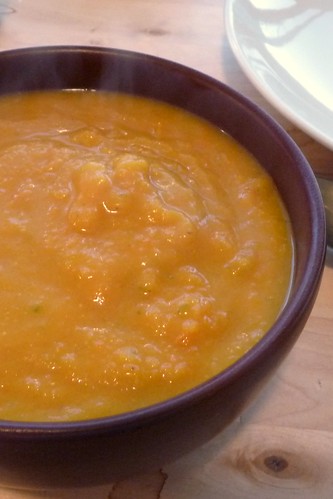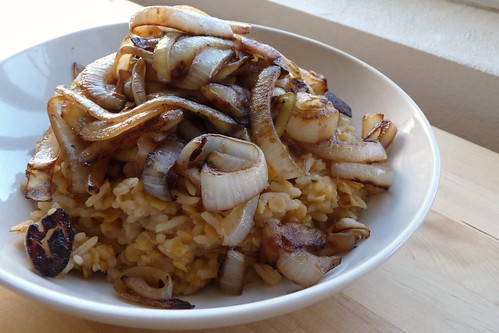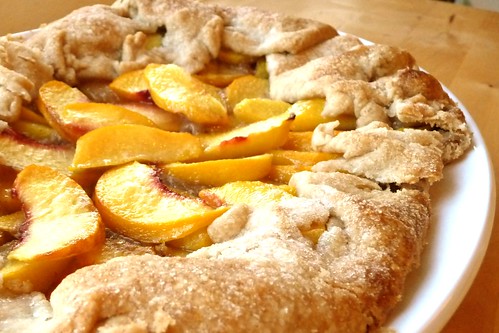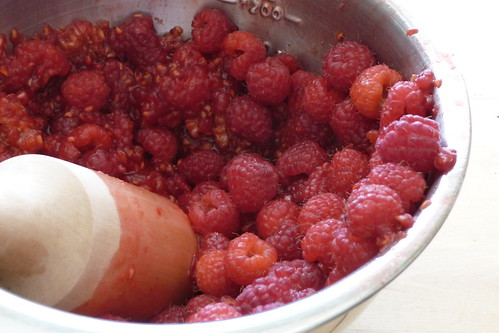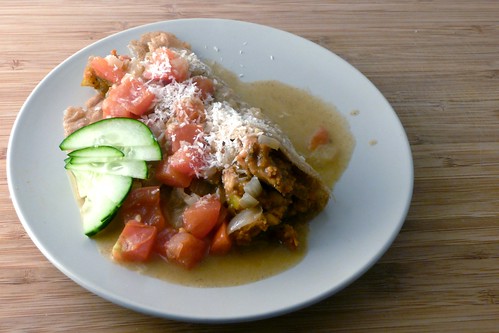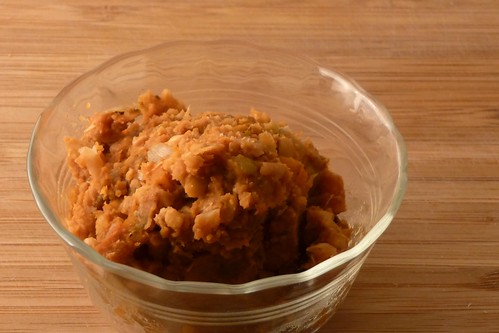Middle Eastern Eggplant Spread

I love eggplant, but most of the year I can't have it for various reasons (too expensive, too out-of-season/icky-looking). It's been in season for a little while, finally showing up at my local farmer's market where I scored a lovely, large specimen for less than a dollar.
Now I've been indulging in a lot of eggplant this summer, from stir-fries with crispily fried eggplant cubes, to my favorite Strange-Flavor Eggplant dip, to Ratatouille, and even Eggplant Parmesan, which I've been known to make three days running. What else could I do with it?
After looking around, I decided on a recipe called "Middle Eastern Eggplant Spread" that sounded interesting. It's from a book I checked out a little while ago from the library called The Roasted Vegetable by Andrea Chesman.
Being me, I didn't stick to the recipe very well. For one, it was missing an essential ingredient: garlic. Horrors! Since the oven was already running, it was pretty easy just to throw in half a head of garlic to roast alongside the eggplant.
It's not a particularly fast lunch to prepare at almost an hour, but the majority of the time is unattended, so it's a good weekend lunch to prepare while you're busy with chores.
Middle Eastern Eggplant Spread [printable recipe]
Adapted from The Roasted Vegetable by Andrea Chesman
Serves 3
- 1 lb eggplant (about 1 medium)
- 1 medium onion, thinly sliced
- 1 tbsp olive oil
- juice of 1 lemon
- 2 tbsp parsley, finely chopped
- 2 tbsp chives or green onions, finely chopped
- 1 tbsp cilantro, finely chopped
- 1/2 head garlic
- salt, pepper
- pita or other flatbread
- tomatoes, chopped
- tzatziki sauce (optional)
Preheat oven to 400F. Pierce eggplant several times with a fork or sharp knife and rest on a baking sheet. Drizzle a little bit of olive oil over the garlic and wrap in foil before placing it next to the eggplant. Roast garlic and eggplant for 40 - 60 minutes until tender and soft.
Toss onions with olive oil and a pinch of salt. Over low heat, cook onions in a large skillet until caramelized (dark brown and very soft), stirring occasionally, about 30 - 40 minutes. If desired, add a pinch of sugar with the salt to aid the caramelizing. (This can be done faster on higher heat, but since the eggplant has to cook for 40 minutes, might as well do it the slow and easy way.)
Remove eggplant and garlic from the oven and allow to cool for a few minutes. Peel eggplant and remove stem. Chop finely and remove to a medium bowl. Squeeze cloves out from papery husks and add to eggplant.
Add cilantro, parsley, chives, lemon juice, salt and pepper to eggplant-garlic mixture. Mash together well. Let rest for 30 minutes to allow the flavors to blend before serving warm or at room temperature.
Spread on pita, top with chopped tomatoes and tzatziki sauce or use as a dip with flatbread or chips.
Notes:
- The original recipe called for the onions to be caramelized in the oven for 20 - 25 minutes. I tried that, it didn't work for me. I'll stick to caramelizing on the range, which works like a charm.
